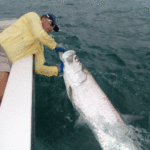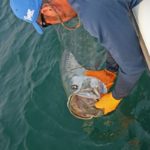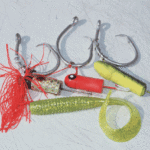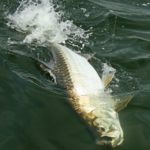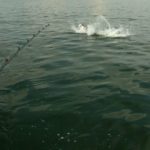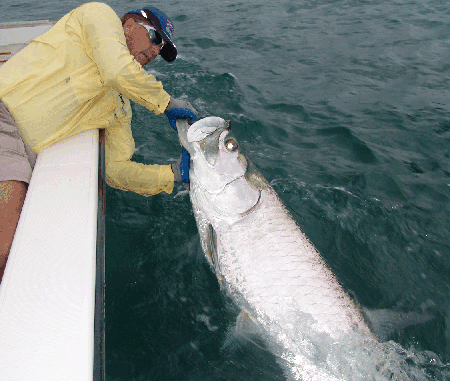
Just go ahead and sleep in. The best tarpon fishing off the mouth of the Mississippi River usually begins after lunch.
We were actually looking for kingfish, but a different king — this one also robed in silver — came to play, and the day turned interesting in a hurry.
Launching from Venice Marina one balmy August afternoon, I was headed out for what was to be a quick photo shoot with Scomberomorus cavalla — the toothy king mackerel. My hosts were Capts. Brandon and Brent Ballay — brothers and fixtures in the Delta fishing scene. Both felt confident that we could wrangle up a picture-worthy king in short order, so off to the rigs we went.
A few miles outside of South Pass, we saw a pair of frigate birds hovering in tight circles — generally a sign of something big feeding below. Eager to see what the birds had seen, we ran to inspect the area. We figured we would find a school of small kings or Spanish mackerel crashing bait, but the water was undisturbed — for the moment.
As we idled in the area, we heard a very distinctive splash, followed by another, then another. Turning toward the sound, we caught a glimpse of something shiny. It was tarpon — loads of tarpon. As if someone had blown a whistle, several hundred silver kings rose and started rolling in the most mesmerizing piscatorial parade I’ve ever seen.
If you’ve ever seen a herd of wild horses galloping full speed across a plain, then just imagine those horses wrapped in aluminum foil, and you’ll get the picture. Powerful, majestic, entrancing — it’s difficult to overstate the grandeur of big numbers of big tarpon on the move.
As Ballay explained, this scene plays out around sunset most summer days at the mouth of the Big Muddy. With the setting sun casting a warm glow across the Delta, thousands of hungry tarpon invade the Gulf of Mexico’s shallow doorstep.
Anglers often call this “Afternoon Delight,” a much-anticipated, end-of-the-day glory shot occurring in the last hour or so of daylight near the South Pass Mud Lumps. Here, and at the Thomasson Lumps off Northeast Pass, decades of Mississippi River mud accumulation once reached several feet above the surface, but today’s structures are much less visible.
Venice guide Capt. Anthony Randazzo said these areas have changed significantly over the past few years, but their subsurface appeal — current dynamics and baitfish — still attracts tarpon.
“The lumps are mostly underwater now, and will never resurface,” he said. “Erosion has beaten them up, and new deposits of sediment are simply washing out to sea. But tarpon still relate to the irregular bottom contours.”
Despite the ever-changing nature of the lumps, one thing remains constant — this area attracts big tarpon.
“When the rod bends down there, you expect a 130- to 140-pounder,” Brent Ballay said.
Catches of 200-pounders, while certainly not common, do occur — as do high numbers. Brent said that in his best Afternoon Delight performance, he left Venice Marina at 2:30 p.m., made the 25-mile run to South Pass, and by 6:30 he and his crew had tagged and released seven big fish.
So, what’s the enticement that accounts for such tremendous tarpon congregations? Simple. It’s the same motivation affecting everything else with an appetite — food. The delta’s cupboard is never empty, and the delta never sends a hungry tarpon to bed without dinner. With its spider web of tributaries flowing toward the Gulf from the river proper, this 24/7 food factory sends daily deliveries of crabs and baitfish to grateful patrons in silver attire.
“The tarpon are all up on top gulping rain minnows, crabs and ribbonfish,” Brent said. “Baitfish will blanket the surface, and the tarpon will ball them up so they get a five-gallon bucket full in each bite.”
Particularly entertaining, Brent said, are the lanky ribbonfish. With toothy, wolf-like faces and slender bodies resembling a pirate’s cutlass, ribbonfish congregate topside, leaping and splashing in a tantalizing display. Ribbons fancy illumination, and that can lead to entertaining moments.
“If you have lights on, (tarpon) will just about jump in the boat trying to get the ribbonfish,” Brent said.
Prime season for Afternoon Delight is August-October. Tides aren’t a huge factor, but you’ll appreciate windless days. Choppy conditions decrease visibility across the surface and make spotting tarpon difficult.
Presentations
Here’s a straightforward routine for engaging the silver cyclones of South Pass: Start just beyond the Mud Lumps and work the drop-off in the 40- to 80-foot range. Keep watch for the sea’s hints — birds circling or working the surface, bait showers and the telltale splashes of feeding fish.
Patience is no virtue in this game. It’s more of a run-and-gun deal. Zigzagging through the tarpon lane, Brent keeps an eye on his depth finder until he spots fish deep or runs across surface action. When he locates his quarry, he’ll set out a spread upcurrent, cut the engines and drift into the fish.
“It’s a sneak attack,” he said.
Now, tarpon are obviously dining on live meals, but savvy anglers will stick with artificial presentations. A well-placed natural bait like a pogie, mullet or greenback will meet with enthusiastic acceptance, but more often than not, the taker will be someone other than your silver quarry. Sure, tarpon will grab these baits when they reach them first, but with so many other mouths seeking an easy meal, natural baits can lead to a lot of wasted time.
“You’ll wear yourself out on the sharks and jacks,” Brent said.
The longstanding favorite for Delta tarpon fishing is the venerable Coon Pop — the creation of Louisiana tarpon fishing pioneer, Lance “Coon” Schouest. Tiring of tarpon giving him the slip by either chomping on his artificial lures until they found the right angle to dislodge the hook, or simply shaking their heads to effect the same result, Schouest designed a bait that would beat the tarpon at its own game.
The Coon Pop consists of a torpedo-shaped head with an anterior metal stem designed to hold a soft plastic tail in place. The head is wire-wrapped to a 12/0 circle hook, so when a tarpon leaps and shakes its jaws, the head and tail detach and the fish remains hooked. With no leverage points, the fish is less likely to come unbuttoned.
Brent uses 3- to 5-ounce heads with Cocahoe, curl or twin-tail soft plastics in green, chartreuse or red/white patterns. The fish may show varying preferences day-to-day, so experiment with multiple tails and colors until you dial in what the fish want.
As in any circle-hook application, resist the temptation to set the hook. Rather, reel steadily and keep a tight line on the fish. The circle hook is designed to roll forward in the fish’s mouth and end up latched around the jawbone. A sudden jerk will snatch away the lure before the hook can grab.
Rigging option: Prior to deploying a new Coon Pop, bite an inch off the plastic body, then snip off the holding wire’s standard bend and create a new one with the shortened stem. This creates the look of smaller bait, often the only thing a tarpon will eat.
Fight the good fight
For tackle, Brent uses stout rods with Penn International 30s or 50s, spooled with 50-pound line. For trolling, he’ll use 7 feet of 200- to 300-pound monofilament leader. For casting, he shortens the leader to 3 feet.
“The reason we use the heavy line is that there’s just millions of little Spanish mackerel in there, and I can’t tell you how many times they’ve cut our lines,” Brent said. “When a tarpon’s coming in from 40 or 50 feet, that line is cutting a V through the water.
“Those mackerel think it’s a minnow cutting across the water, and they come up and jump on it.”
When all proceeds as planned and a hooked tarpon stretches your line, you’ll quickly learn those beautiful silver scales house a raging spirit that will test your tackle and your resolve. The first run is the best, as a fresh fish burns off and surfaces in a gill-rattling, tail-walking temper tantrum bristling with attitude. Afterward, expect a stubborn tug-of-war punctuated by a few more leaps and lots of thrashing. Best bet for fighting a big tarpon is to strap on a fighting belt, plant the rod butt and hold your ground. Let the fish run when it feels the urge, but crank up all slack the moment your fish tires.
Properly handling a tarpon’s leaps is essential to a successful conclusion. When the fish jumps, it often lands on the line, thereby breaking the connection. Counter this move by “bowing” to the tarpon. Some glorify this as a gesture of respect for the silver king, but we can dispense with the drama — it’s more function than form. When the fish jumps, point the rod toward the water and bend at the waist. Sounds silly, but those who refuse to bow typically lose their tarpon.
Respect the king
Even after a quick fight, a caught tarpon will need a moment to catch its breath before swimming back to the school. With engines in idle, lean over the gunwale, grip the tarpon’s stout lower jaw and support the fish’s midsection. This allows a steady flow of oxygenated water over the tarpon’s gills. Such effortless breathing enables the tired fish to recharge its batteries in only a few minutes.
Anglers interested in contributing to tarpon research can do so prior to release by collecting a small DNA sample and submitting it to Florida’s Fish and Wildlife Research Institute, where biologist Kathy Guindon heads up a cutting-edge program that tracks the movement of tarpon throughout their range. Samples from all Gulf states are welcome. For details, see sidebar.
Lastly, minimize noise and you’ll maximize your productivity. Tarpon have good hearing, and even with abundant food present, no potential danger goes unnoticed. Dropping tackle, bumping coolers or slamming hatch lids will send the fish packing and often draw the ire of fellow anglers fishing nearby.
Etiquette is also important to this game. If one boat is working a particular school, give way and wait your turn. Running headlong through the fish can ruin the drift that another captain has worked to establish. Likewise, when another boat hooks up, give way when their fish makes a hard run in your direction. You’ll appreciate the returned favor on your next connection.
